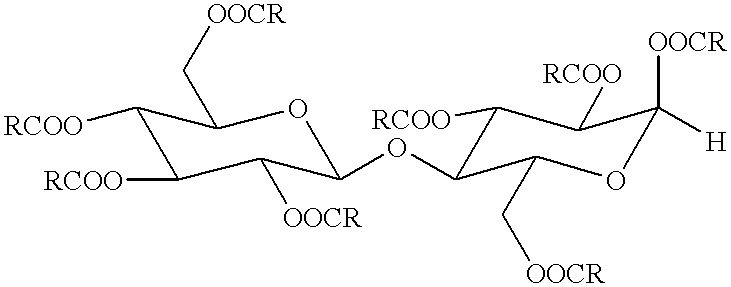Cosmetic compositions
a composition and composition technology, applied in the field of cosmetic compositions, can solve the problems of affecting the effect of cosmetics,
- Summary
- Abstract
- Description
- Claims
- Application Information
AI Technical Summary
Benefits of technology
Problems solved by technology
Method used
Image
Examples
example 1
The enthalpy of gelation was measured for a number of structuring agents in three liquids. In each case the gels are made to contain 7 to 7.5 wt % of the structurant in the liquid.
A sample gel, weighing between 18 and 22 mg was placed in a stainless steel calorimeter capsule, which was sealed with an elastomeric O-ring. The capsule was placed in the DSC at room temperature and heated at 10 K / minute to 150.degree. C., held at 150.degree. C. for 60 seconds and cooled at 2 K / minute to -50.degree. C.
The procedure was repeated with DC 345 alone. The data recorded for DC 345 was subtracted from the data for the gel, so that the gel formation appears a departure from a flat baseline. The gelation enthalpy was calculated as the area between the peak and the baseline.
Values of enthalpy (in kJ / mole) were obtained as set out in the following table
example 2
(Comparative)
Gels were prepared with lanosterol by a standard procedure in which the ingredients of the gel were placed in a 30 ml glass bottle together with a magnetic stirrer bar. The mixture was stirred and heated until all the lanosterol had dissolved. The bottle was then removed from the heat, the stirrer bar taken out and the contents of the jar left to cool to room temperature.
The following was observed: Lanosterol was found to dissolve at 10.0 wt % in Finsolv TN at 83.degree. C. After cooling to room temperature for 1 hours a hard, transparent gel was obtained. However the gel was found to be unstable at room temperature: large crystalline lumps appeared within hours and spread throughout the entire gel leading to is collapse.
Lanosterol was found to dissolve at 5.0 wt % in 80:20 (wt %) DC 345: Finsolv TN at 85.degree. C. After cooling to room temperature for 1 hour a hard, translucent gel was obtained. However the gel was found to be unstable at room temperature: large cryst...
example 3
(Comparative)
Unsuccessful attempts were made to prepare compositions as set out in the table below, using N-lauroyl glutamic acid di-n-butylamide (GP-1) as structurant
The two compositions would have been emulsions where the disperse phase would be a solution of antiperspirant active in water (Zirkonal 50 is a 50% aqueous solution of antiperspirant active).
In each case the components of the continuous phase were placed in a beaker and the mixture heated with stirring on a hot plate until all the GP-1 structurant dissolved. The temperature at which it dissolved is shown in the table above.
The intention was then to cool the mixture, while still stirring gently to about 85-90.degree. C. in order to add the components of the disperse solid or liquid phase. In all cases the continuous phase gelled at a temperature (shown in the table) above or very close to 100.degree. C., which was too high for safe addition of the disperse phase in an open laboratory.
Safe preparation at this high temper...
PUM
| Property | Measurement | Unit |
|---|---|---|
| vapour pressure | aaaaa | aaaaa |
| total weight | aaaaa | aaaaa |
| thickness | aaaaa | aaaaa |
Abstract
Description
Claims
Application Information
 Login to View More
Login to View More - R&D
- Intellectual Property
- Life Sciences
- Materials
- Tech Scout
- Unparalleled Data Quality
- Higher Quality Content
- 60% Fewer Hallucinations
Browse by: Latest US Patents, China's latest patents, Technical Efficacy Thesaurus, Application Domain, Technology Topic, Popular Technical Reports.
© 2025 PatSnap. All rights reserved.Legal|Privacy policy|Modern Slavery Act Transparency Statement|Sitemap|About US| Contact US: help@patsnap.com


